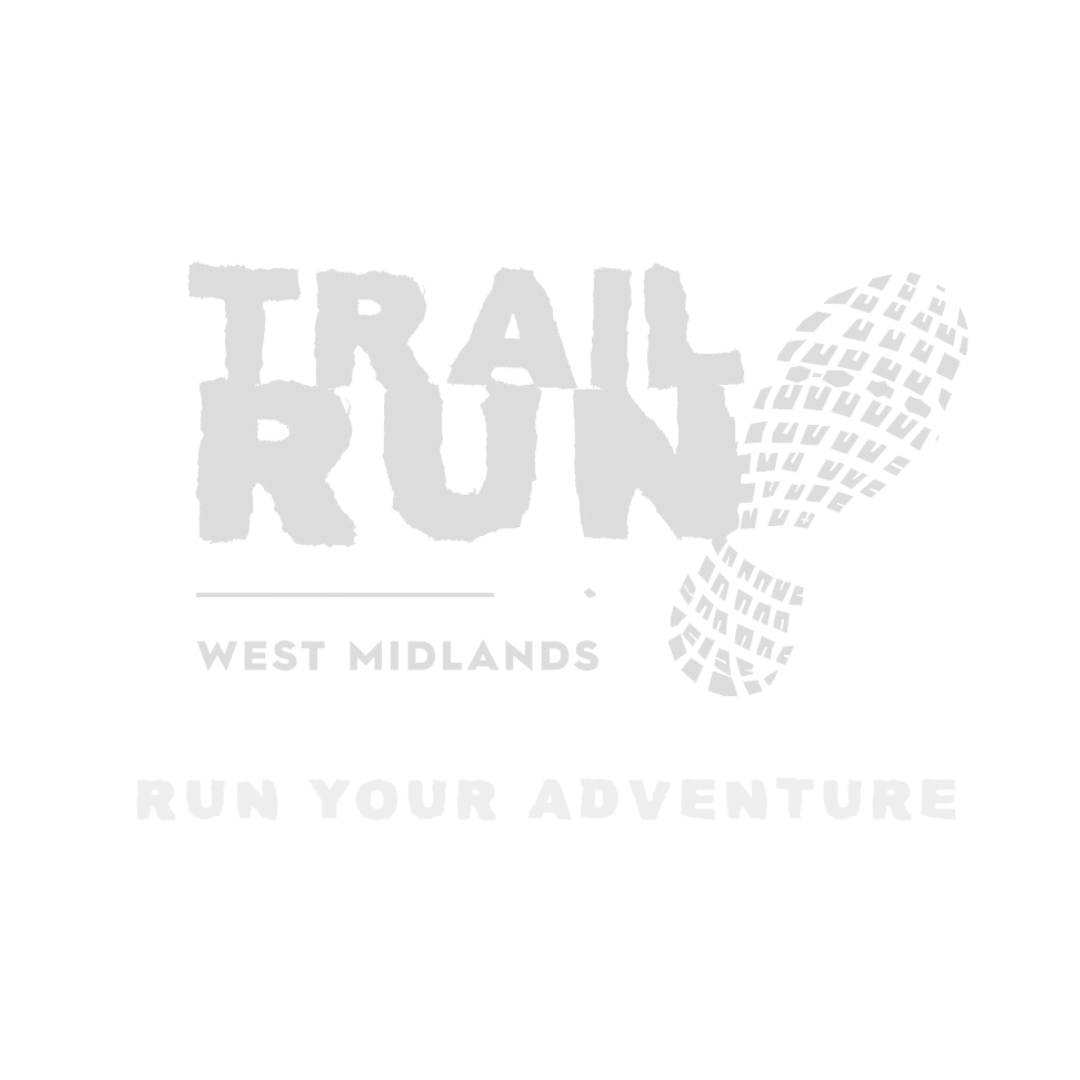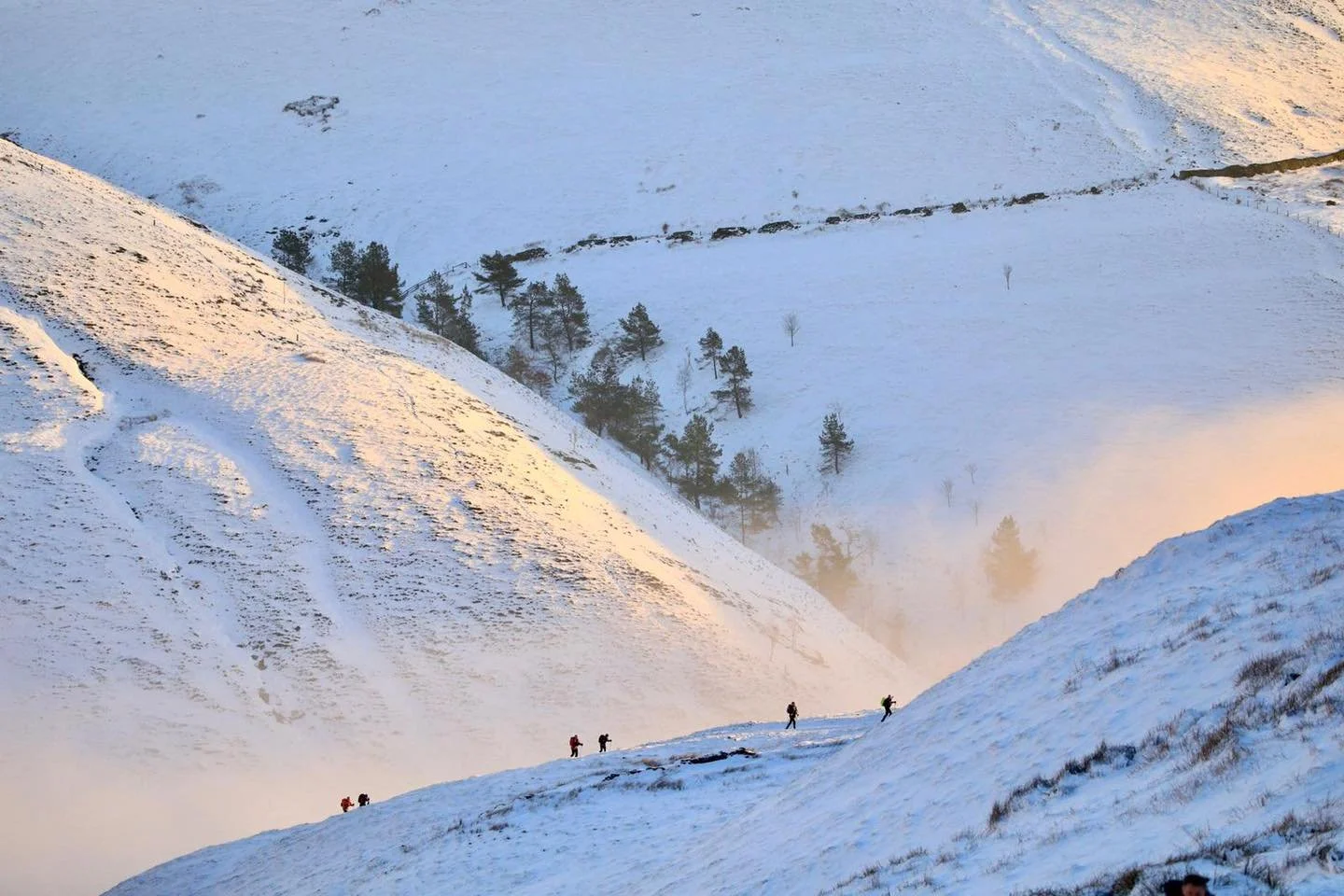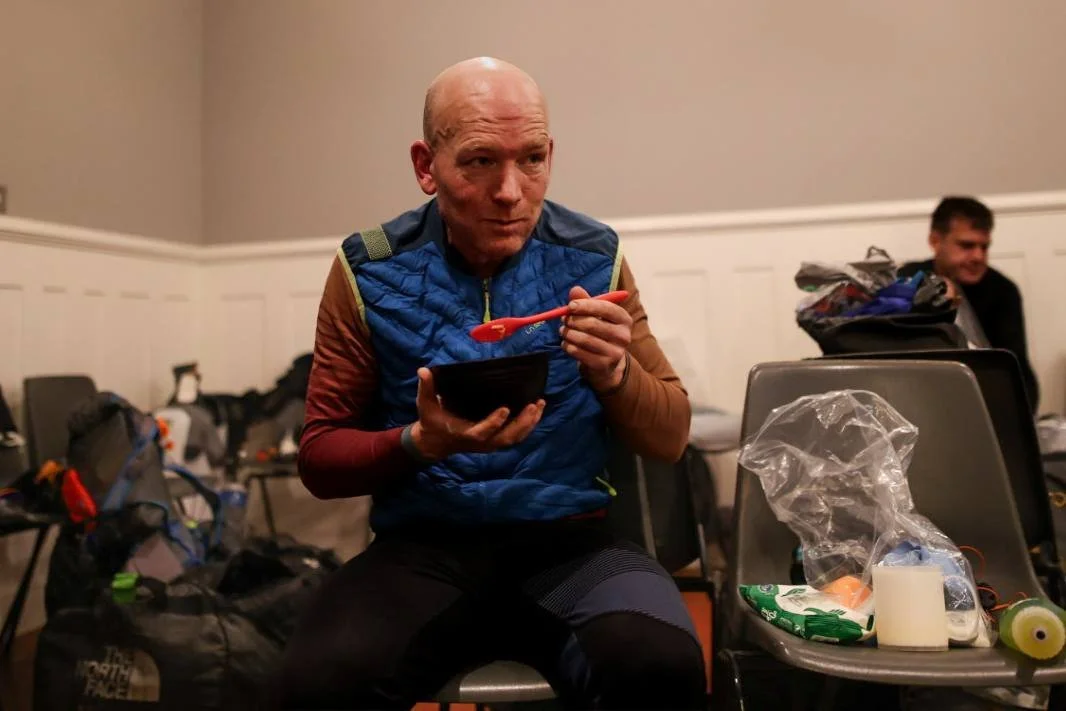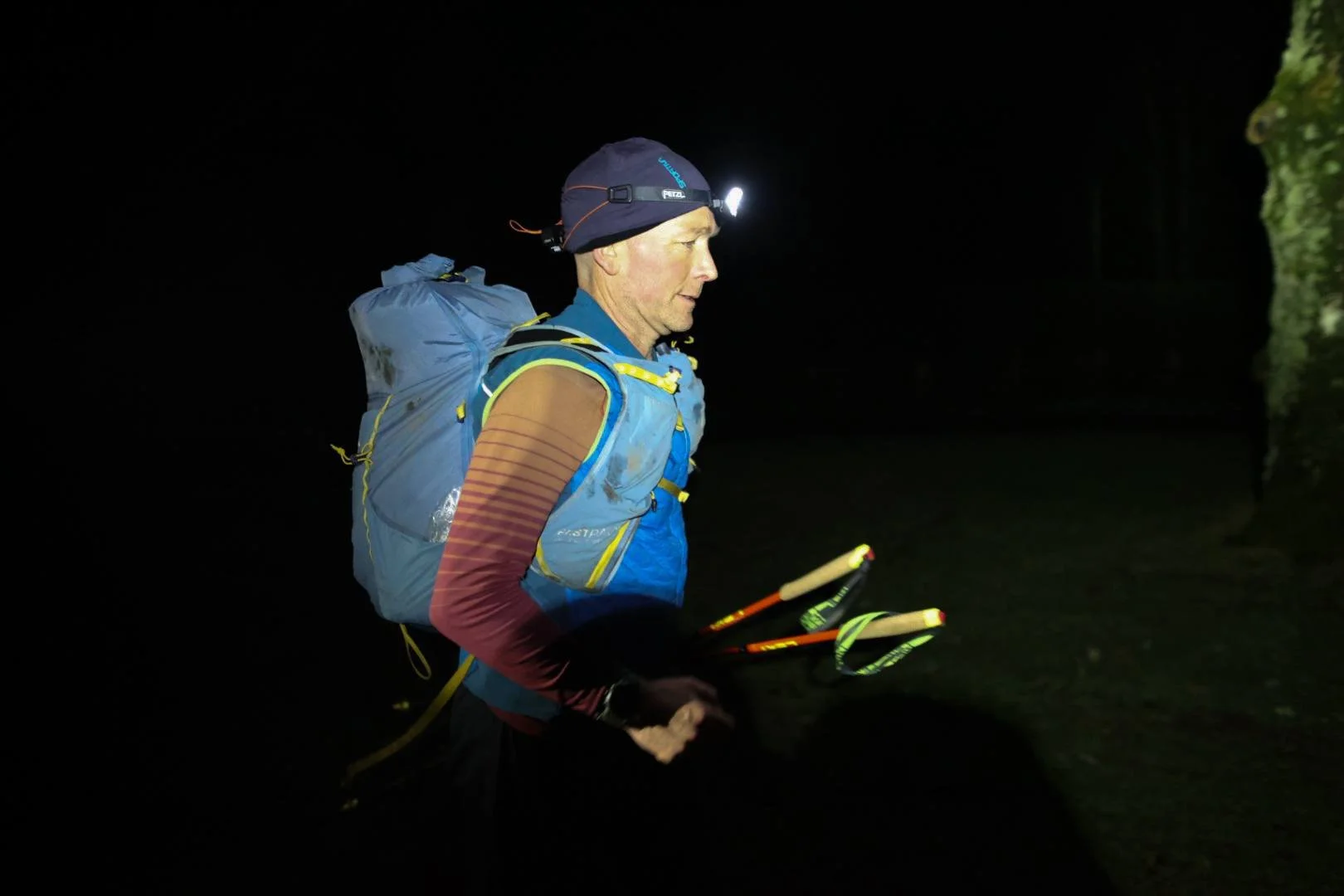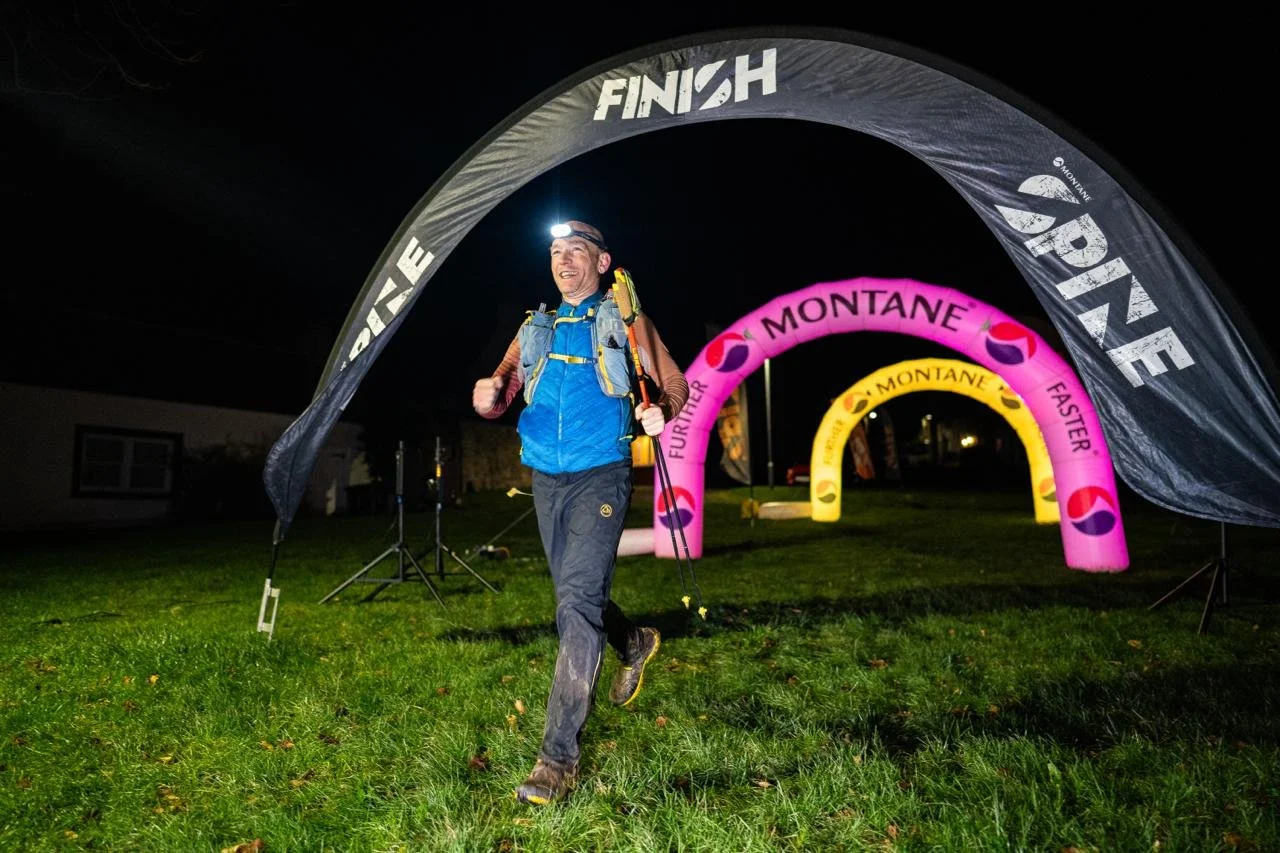Relentless determination: Kim Collison and the Montane spine race
Kim Collison is a living legend in the UK’s off road running scene. A decorated fell runner including breaking the Bob Graham winter round record in 2019, breaking the record for the Lakeland 24hr record in 2020, Paddy Buckley round record in 2021, and also the 24hr munro record the same year, it seems he is a natural when it comes to rugged terrain, hills, and long distance. In 2014, with victory at the Lakeland 50, he was British Trail Running Champion and went on to achieve a number ultra records on the trails including Hardmoors 55 (55 miles), Lakeland Trails 110km (65 miles), Lakes in a Day (50 miles) and Arc of Attrition (100 miles).
Snowy conditions (Photo Montane Spine Race)
I first met Kim when I hosted a Fell Coach in Running Fitness course, and was in awe, of this amazing athlete. Like me he is a coach, we exchange messages frequently especially if i’m seeking some advice about races in the north of England, and he always comes up in conversation with my friend Graeme Woodward who is Kims Strength and conditioning, and Nutritional coach.
A few years back, the Montane winter spine race became the target of Kims next obsession.
A non-stop 268 mile race along the pennine way with a time limit of 168hrs, and climbing 10’000m, the current record holder is Jack Scott who finished it in 2024 in 72hrs, 55min and 5 seconds.
It starts in the second week of January, at Edale, Derbyshire, covering hostile terrain, and fells, including the Peak District, Yorkshire Dales, Northumberland National Park, finishing at Kirk Yetholm on the Scottish Border. 150 people are able to enter the full spine race, and its likely at least 50% will be timed out or withdraw.
Weather conditions can hit -15, you can expect the harshest of weather, and in 2025 we had a dumping of snow, which would make the conditions very interesting.
Kim had attempted the Spine on three other occasions, having to DNF through injury, however what was different in 2025, how did he approach the race this time and what had he learnt?
I contacted Kim and he kindly agreed to answer some questions over email for this blog, to give an insight into how to best prepare for this type of event, how mindset helped him overcome previous attempts, and ultimately what he did to finally win the Winter Montane Spine!
Q - Why the winter spine, what drew you to the event, the winter conditions and the distance?
A - After listening to a podcast with Sabrina Vergee, who made me realise the Spine was my next big challenge. I had done a lot of hard things and set records on the fells with the rounds, it was a natural progression to turn to the Spine. The distance and time of year created a new exciting adventure to work hard towards.
Q - What was your focus training wise?
A - After Swiss Peaks initially I had a big focus on improving my fitness and speed. In order to compete for the win, I needed to be able to compete in the early parts of the race. There was always a focus on a big mountain run to build specific endurance. Later in the block I focused on some long hard workouts and only a handful of runs with the full pack.
Q - How important are the recces?
A - This year I only recced the last 100km to refresh the section I had least knowledge of, the rest I wanted to keep as fresh as possible. However over the 4 years I had good knowledge of what to expect from previous races and training runs. It’s certainly an advantage to know where you are going before you get there.
Q - How did you approach your admin during the race, looking after your feet, keeping warm, dealing with the cold and snowy conditions?
A - Each checkpoint I focused on my feet to clean, dry, tape and replace new socks which is really important to try to have reasonable feet for later in the race. You have to be proactive during this race with your admin, add layers, do waterproof cuffs up, hood up early, remove layers, hydrate, eat, keep on top of the admin but don’t use it as an excuse to rest.
Kim taking on fuel (photo Montane Spine Race)
Q - kit wise, how do you manage the balance between kit requirements and weight?
A - It’s worth spending or borrowing the lightest kit if you are aiming to compete but can make different choices if completion is the main goal. Remember to think about the kit depending on the weather conditions. Do I need a heavy waterproof? Do I need a big warm insulated layer later in the race when moving slowly and super tired.
Q - How do you approach speaking to your coach about your big audacious events?
A - Being self coached I think to myself does this big goal excite and inspire me? Is it on the edge of possibility? Is failure possible?
Q - What do you attribute to your finish this year, I know you took a power nap which you have never done on this event before, but what else?
A - Taking the oppurtunity to sleep at Hawes, fuelled the first section with more Carbs, worked with a Physio to help rebalance my biomechanics, continued belief in my ability.
Kim moving through the night (Photo Montane Spine Race)
Q - What changed nutrition wise and what was your balance between gels/real food?
A - I consumed around 100g CHO for first 8 hours to Hebden Bridge. This dropped to around 80g CHO per hour to Hawes but started to include solid fuel including fats and proteins. After Hawes a lower number of overall calories but now 50 % fast sugars and 50 % solid foods including nuts, chocolate & cheese.
Q - How did you remain mentally focused, and how important was having a plan and self talk?
A - Maintaining focus when sleep deprived to minimise mistakes and reduce faff stops is crucial to save time. Same as having a plan before entering a checkpoint, I like to organise kit straight away so ready to depart even if I am going for a sleep. Developing your positive self talk and focusing on enjoying the moment are really important, as are developing strategies to counter the dark moments when they arrive in your mind. When it gets hard and painful, I find shouting at myself very motivating and bargaining with my chimp ego Reggie works well.
Q - What advice do you have for anyone wanting to step up to the triple figure distances (100mile +)?
A - Patience. Don’t rush the journey to 100 mile + adventures. Get good at power hiking.
Q - How important is recovery, and have you had the night sweats?
A - These big multi day races take a long time to recover from fully. The acute stage of night sweats, swollen feet, achey joints can be quite uncomfortable for several days. The legs and body can feel like they recover quite well but often the HRV is a clue that the internal impact can last several weeks. So once able to train again, focus on rebuilding endurance, strength and small doses of speed for the nervous system without the pressure of hard workouts until you feel good and motivated again.
Q - How advantageous is it to have a coach and what would you look for in a coach eg qualifications, and do they have to have done the event to coach the event?
A - Do they inspire me, do they support me, do I improve knowledge to aid my growth, can I build rapport with them and do they have similar values. There is massive value in working with a coach or a range of experts, often we benefit with the power of a team.
Thank you Kim for taking the time to answer these.
Kim Collison’s triumph at the Montane Winter Spine Race is a testament to relentless determination, meticulous preparation, and the power of learning from setbacks. His journey from three DNFs to victory speaks volumes about the importance of adaptability, patience, and unwavering self-belief.
From his precise attention to race-day admin to his ability to confront mental and physical challenges head-on, Kim has proven that success in ultra-endurance events goes far beyond physical fitness—it’s about mindset, strategy, and the courage to embrace the unknown. His advice to focus on the journey, hone foundational skills, and build a supportive team resonates deeply, not just with aspiring ultra runners, but with anyone striving for their own audacious goals.
Kim’s story reminds us that even the most challenging paths can be conquered with persistence and passion. Whether you’re chasing a finish line, a personal milestone, or a dream, the spirit of resilience and curiosity, Kim serves as a powerful inspiration.
In his own words: “Does this big goal excite and inspire me? Is it on the edge of possibility?” Perhaps, like Kim, it’s time to ask yourself the same—and take that first step toward your next adventure.
Kim Finishing the Montane Spine Race 2025, 1st place (Photo Montane Spine)
